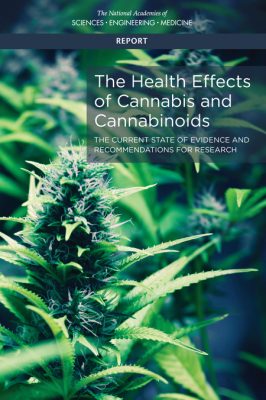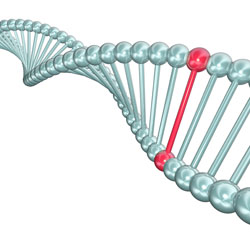National Academy of Sciences, Engineering and Medicine Issues Report on the Health Effects of Cannabis
 In early 2017, the National Academy of Sciences, Engineering, and Medicine issued its first comprehensive report on cannabis since 1999. Shifting public opinion over the past few decades has led to 28 states and the District of Columbia legalizing medical uses of marijuana, and eight states and DC legalizing recreational marijuana use. The Health Effects of Cannabis and Cannabinoids: Current State of Evidence and Recommendations for Research is intended to address the lack of accepted standards to guide individuals in deciding whether and how to use cannabis safely. In addition to summarizing recent health-related findings on cannabis, the report also offers recommendations to guide future research.
In early 2017, the National Academy of Sciences, Engineering, and Medicine issued its first comprehensive report on cannabis since 1999. Shifting public opinion over the past few decades has led to 28 states and the District of Columbia legalizing medical uses of marijuana, and eight states and DC legalizing recreational marijuana use. The Health Effects of Cannabis and Cannabinoids: Current State of Evidence and Recommendations for Research is intended to address the lack of accepted standards to guide individuals in deciding whether and how to use cannabis safely. In addition to summarizing recent health-related findings on cannabis, the report also offers recommendations to guide future research.
The report shares findings about possible therapeutic benefits to cannabis use as well as health impacts relating to areas such as cancer, respiratory disease, immunity, pre- and post-natal health.
There were several notable findings with regard to mental health. The committee that issued the report found substantial evidence of a statistical association between cannabis use and the development of schizophrenia or other psychoses, with the highest risk among the most frequent users.
The committee also found moderate evidence of a link between cannabis use and increased symptoms of mania and hypomania in people with bipolar disorder who use cannabis regularly. The report also describes moderate evidence of an association between heavy cannabis use and increased suicidal ideation and suicide attempts.
There was also moderate evidence that regular cannabis use is linked to social anxiety disorder.
The report described factors that may lead to problem cannabis use. The committee found substantial evidence that being male, smoking cigarettes, and beginning cannabis use at an earlier age are risk factors for developing problem cannabis use. Read more
BNN Editor Robert M. Post Wins Mogens Schou Award for Research from the International Society for Bipolar Disorder
On May 4, 2017, at the annual conference of the International Society for Bipolar Disorders (ISBD) in Arlington, Virginia, Dr. Robert M. Post, Editor-in-Chief of Bipolar Network News, was presented the Mogens Schou Award for Research. It is one of the most prestigious honors in the field of research on bipolar disorder.
Mogens Schou was a Danish psychiatrist and researcher whose research in the 1950s led to lithium’s use in the treatment of bipolar disorder.
Upon the announcement of the award by Dr. Marion Leboyer, who received the Schou research award in 2011, Dr. Post received a standing ovation. The following comments are adapted from Dr. Post’s acceptance speech.
“It is the highest honor I could imagine to receive an award from the ISBD in the name of Mogens Schou. Not only did Schou pioneer the development of lithium for the recurrent mood disorders, but he beat back the British naysayers and critics (Michael Shepherd and Harry Blackwood) by conducting the definitive long-term controlled studies of lithium, and then continued to promote its benefits.
In Schou’s obituary, fellow researcher Dr. Paul Grof wrote,”What was most striking and profound about him was his love and compassion for people.” Schou himself said upon receiving an award, “For me every single patient whose life was changed radically by lithium outweighs honors and awards.”
Thus, it is only appropriate that I relay some of the new data on the broad clinical effects of lithium, especially since lithium today is used way too infrequently, particularly in the United States. This list is a bit too condensed, but LITHIUM: increases neuroprotective factors and neurogenesis (adults like me in the room are happy to know that we are still making new neurons). Lithium increases the volume of the hippocampus and cortex, and blocks cell death.
Lithium prevents mania, depression, and even recurrent unipolar depression, and reduces suicides 10-fold.
Lithium lengthens telomeres [bits on the ends of DNA that protect it during cell replication] back to normal, enhances health and longevity, decreases the incidence of some neurological diseases (including dementia), and half a pill a day for one year prevents the progression of mild cognitive impairment.
Remarkably, higher trace amounts of lithium in drinking water prevent suicide in the general population. This has now been shown in more than a half dozen studies that compare naturally occurring levels of lithium in the water in different geographic areas.
No other drug comes close to having this range of benefits. So I can only reiterate a message Schou was determined to spread in his final years: “We need to use lithium more often.”
If Schou had seen the excess of childhood-onset bipolar disorder in the United States, he would surely have lobbied for better treatment of these young people and more treatment research.
I thank the ISBD for this great honor and the opportunity to try to foster Schou’s ideals.”
Continuing Marijuana Use After a First Episode of Psychosis Increases Risk of Relapse
 A 2016 article in the journal JAMA Psychiatry reports that continuing to use cannabis after a first episode of psychosis increases risk of relapse. The study by Sagnik Bhattacharyya and colleagues employed longitudinal modeling to determine the role of cannabis use in psychotic relapse. The researchers followed 90 women and 130 men for two years after a first episode of psychosis, and found that the more marijuana they used, the more likely they were to have a relapse of psychosis.
A 2016 article in the journal JAMA Psychiatry reports that continuing to use cannabis after a first episode of psychosis increases risk of relapse. The study by Sagnik Bhattacharyya and colleagues employed longitudinal modeling to determine the role of cannabis use in psychotic relapse. The researchers followed 90 women and 130 men for two years after a first episode of psychosis, and found that the more marijuana they used, the more likely they were to have a relapse of psychosis.
Relapse rates were highest (59.1%) for participants who used pot continuously following their first episode of psychosis. Relapse rates were lower (36.0%) for those who used cannabis intermittently thereafter, and lowest (28.5%) among those who discontinued cannabis use after their first episode of psychosis.
A statistical test known as a cross-lagged analysis was used to establish that cannabis use affected later relapse, rather than relapse of psychosis leading to further cannabis use.
Another statistical strategy using fixed-effect models revealed that risk of psychotic relapse was 13% higher during times of cannabis use than during periods of no cannabis use.
These findings offer some hope that the likelihood of psychosis relapse can be reduced, since ongoing cannabis use is a risk factor that can be modified, unlike family history or genetics. Bhattacharyya and colleagues called for research into interventions that can help discourage cannabis use in people who have had a first episode of psychosis.
Editor’s Note: N-acetylcysteine, a nutritional supplement sold in health food stores, can reduce cannabis use compared to placebo in teen users.
Early Cannabis Use and BDNF Gene Variant Increase Psychosis Risk
 Normal variations in genes can affect risk of mental illness. One gene that has been implicated in psychosis risk is known as BDNF. It controls production of brain-derived neurotrophic factor, a protein that protects neurons and is important for learning and memory. Another important gene is COMT, which controls production of the enzyme catechol-O-methyltransferase, which breaks down neurotransmitters such as dopamine in the brain.
Normal variations in genes can affect risk of mental illness. One gene that has been implicated in psychosis risk is known as BDNF. It controls production of brain-derived neurotrophic factor, a protein that protects neurons and is important for learning and memory. Another important gene is COMT, which controls production of the enzyme catechol-O-methyltransferase, which breaks down neurotransmitters such as dopamine in the brain.
Several forms of these genes appear in the population. These normal variations in genes are known as polymorphisms. Certain polymorphisms have been linked to disease risk. A study by Anna Mané and colleagues published in the Journal of Psychiatric Research in 2017 explored links between COMT and BDNF polymorphisms, cannabis use, and age at first episode of psychosis.
Mané and colleagues found that among 260 Caucasians being treated for a first episode of psychosis, the presence of a BDNF polymorphism known as val-66-met and a history of early cannabis use were associated with younger age at psychosis onset.
The val-66-met version of BDNF occurs in 25-35% of the population. It functions less efficiently than a version called val-66-val.
The researchers also found that males were more likely to have used cannabis at a young age.
Editor’s Note: In the general population, marijuana use doubles the risk of developing psychosis. Previous data had indicated that the risk was higher for those with a COMT polymorphism known as val-158-val that leads to more efficient metabolism of dopamine in the prefrontal cortex. The resulting deficits in dopamine increase vulnerability to psychosis compared to people with the val-158-met version of the COMT gene.
The new study by Mané and colleagues suggests that a common form of BDNF may be associated with an earlier onset of psychosis. Bottom line: Pot is dangerous for young users and can induce psychosis, particularly in people at genetic risk. Pot may be legal in many places, but heavy use in young people remains risky for mental health and cognitive functioning.
The company Genomind offers genetic testing for BDNF and COMT variants as part of a routine panel.
Cannabis Use May Cause Schizophrenia
 Cannabis use has been linked to schizophrenia risk, and new genetic research suggests a causal relationship between the two. In a 2017 article in the journal Molecular Psychiatry, researcher Julian Vaucher and colleagues reported that lifetime cannabis use was linked to schizophrenia even when the researchers controlled for 10 genotypes weakly associated with lifetime cannabis use. This makes it unlikely that the schizophrenia caused the cannabis use, suggesting instead that it is the cannabis use that leads to a schizophrenia diagnosis.
Cannabis use has been linked to schizophrenia risk, and new genetic research suggests a causal relationship between the two. In a 2017 article in the journal Molecular Psychiatry, researcher Julian Vaucher and colleagues reported that lifetime cannabis use was linked to schizophrenia even when the researchers controlled for 10 genotypes weakly associated with lifetime cannabis use. This makes it unlikely that the schizophrenia caused the cannabis use, suggesting instead that it is the cannabis use that leads to a schizophrenia diagnosis.
Vaucher and colleageus also controlled for genetic associations between cigarette smoking and cannabis use to eliminate cigarette use as a third variable causing the association between cannabis and schizophrenia.
The study by Vaucher and colleagues included 34,241 people with schizophrenia and 45,604 healthy controls.
Adherence to Antidepressants Associated with Lower Mortality
A large study from Israel suggests that over a 4-year period, people who regularly took their prescribed antidepressants were less likely to die of any cause during that period.
The study, published in the Journal of Clinical Psychiatry in 2016, used data from an Israeli health provider that covers 53% of the nation’s population. It included 251,745 patients aged 40 and up who filled a prescription for an antidepressant at least once between 2008 and 2011.
Researchers led by Amir Krivoy looked at how much of the time people actually filled their prescriptions. Patients who filled their prescriptions more of the time were less likely to die during the study period than those who did not fill their prescriptions regularly.
Editor’s Note: This study by Krivoy and colleagues provides more evidence of the benefit of long-term antidepressants. People who have had two or three episodes of unipolar depression should consider long-term prevention with antidepressants over the course of their lifetime, in the way that people take blood pressure medications long-term to prevent heart attacks. In addition to lowering mortality, antidepressants also reduce the rate of relapse by 75% compared to placebo. More time on antidepressants also preserves hippocampal volume with aging.
In Population Near Uranium Plant, Headaches Predicted a Thyroid Problem
People with headache disorders may be at greater risk of developing hypothyroidism, a condition in which the thyroid does not produce enough thyroid hormone and various body processes start to slow down. A study by researcher Andrew Martin and colleagues in the Journal of Head and Face Pain is the largest to examine the likelihood that headache sufferers may be at risk for hypothyroidism.
About 2% of Americans develop hypothyroidism. The study by Martin and colleagues used data from a 20-year medical monitoring program for people who lived near a uranium processing plant in Ohio. The authors reported that people with pre-existing headache disorders had a 21% increased risk of new onset hypothyroidism during that period, while people who reported that they had migraines or regularly used headache medication had a 41% increased risk of hypothyroidism. People with migraines were most likely to develop hypothyroidism in the study. Female sex and age are additional risk factors for hypothyroidism. About 12% of the US population experiences migraines.
Melatonin May Improve Headaches
A 2016 article in the Journal of Head and Face Pain reviewed randomized placebo-controlled trials of melatonin for the treatment of headaches. Author Amy A. Gelfand and colleagues reported that 10 mg of melatonin was superior to placebo in the treatment of cluster headaches. For treatment of migraines, 3 mg of immediate-release melatonin improved headaches compared to placebo, while 2 mg of sustained-release melatonin was insufficient.
The authors also found non–placebo controlled data suggesting that melatonin may be helpful for other types of headaches. More research is needed to clarify melatonin’s effects in different headache disorders.
Immune Therapy with IVIG May Help Children with PANDAS
 A small number of children exposed to streptococcal bacteria have an autoimmune response that manifests in sudden, severe obsessive-compulsive behaviors and tics. This disorder is known as PANDAS: pediatric autoimmune neuropsychiatric disorder associated with streptococcal infection, and it resembles the broader disorder PANS, which can occur after other types of bacterial or viral infections.
A small number of children exposed to streptococcal bacteria have an autoimmune response that manifests in sudden, severe obsessive-compulsive behaviors and tics. This disorder is known as PANDAS: pediatric autoimmune neuropsychiatric disorder associated with streptococcal infection, and it resembles the broader disorder PANS, which can occur after other types of bacterial or viral infections.
Research on treatments for PANDAS and PANS is scant, but therapies that target the immune system seem to have more success than typical psychiatric treatments. In a 2015 article in the Journal of Child and Adolescent Psychiatry, researcher Miro Kovacevic and colleagues described a case series of 12 youths with PANDAS who were treated with intravenous immunoglobin (IVIG), a treatment designed to regulate the immune system. (The participants also met diagnostic criteria for PANS.)
The authors suggest that PANDAS symptoms result from a misdirected immune response that attacks the patient’s brain instead of or in addition to attacking the initial infection. IVIG treatment uses a mixture of antibodies from about 1,000 people. When this mixture is infused into the patient’s blood, the antibodies help deflect the autoimmune attack on the patient’s body. All of the 12 patients had a good long-term response to IVIG. Some did well after just one infusion, while two needed a second infusion because they did not respond to the first, and five had recurring symptoms that required a second infusion. All of the patients had previously received two other types of treatment: a 5-day course of steroids and antibiotics, neither of which produced immediate improvements.
The authors concluded that effective long-term treatment of PANS or PANDAS should combine immune therapy, prevention of future infections with antibiotics, and treatment that targets their psychiatric symptoms, such as anti-obsessional medication or cognitive-behavioral therapy.
More News About Genetic Risk for Bipolar Disorder
In a 2017 article in the Journal of Clinical Psychiatry, researcher Paul E. Croarkin and colleagues describe findings from their study of genetic risk factors for early-onset bipolar disorder. The researchers focused on single nucleotide polymorphisms (SNPs), which are variations in a single base pair of a DNA sequence. SNPs are normal variations or copying errors that occur when DNA is replicated. Croarkin and colleagues tracked 8 SNPs that had been linked to bipolar disorder in previous studies. They examined 69 patients from a study of early-onset mania, 732 adult patients with bipolar disorder (including 192 with early-onset illness), and 776 healthy controls. The researchers compared patients with early-onset illness to controls, and also looked for connections between specific SNPs and early-onset illness.
The SNPs analyzed in the study map to three genes that have repeatedly been associated with the risk for bipolar disorder in other studies. These include CACNA1C (one of several genes that create calcium channels), ANK3, and ODZ4. Croarkin and colleagues determined that the presence of these SNPs, particularly the ones that involved the CACNA1C gene, were associated with early-onset bipolar disorder.
Editor’s Note: These findings may lead to better treatment for early-onset bipolar disorder. The CACNA1C calcium influx gene that has repeatedly been connected to bipolar illness can be blocked by the calcium channel blocker nimodipine. Nimodipine has lithium-like effects in mania and depression in adults. One case report by Pablo A. Davanzo in the Journal of Child and Adolescent Psychopharmacology described success using nimodipine and the thyroid medication levothyroxine to treat a 13-year-old boy with very rapid cycling bipolar disorder that had previously failed to respond to multiple medications.
Nimodipine deserves further study in children showing symptoms of bipolar disorder. The company Genomind provides testing for the CACNA1C gene. We hope it will soon be determined whether the presence of this SNP predicts a good response to nimodipine.
Being able to predict who will get bipolar disorder is a long way off. However, there are some clear risk factors. Young people from families that have had several generations of bipolar disorder or related disorders are at increased risk for bipolar disorder. This risk increases for children who experience adversity in childhood, such as abuse or neglect. The presence of early mild symptoms of mania, depression, or disruptive behavior further increase this risk.
For doctors, a patient’s clinical history of these three types of risk factors can help identify whether they are at increased risk of developing bipolar disorder. Patients with several risk factors should be observed closely and treated with psychotherapy or medication as needed.
Parents of children between the ages of 2 and 12 who have shown some signs of mood or behavioral symptoms are encouraged to join our Child Network. We provide a secure online platform where parents record their children’s symptoms of anxiety, depression, attention-deficit hyperactivity disorder (ADHD), oppositional behavior, and mania on a weekly basis. Symptoms are charted over time in a graphical depiction that can be shared with the child’s doctor. For more information, see page 11 of this issue. To join, visit our website bipolarnews.org and click on the tab for the Child Network.






